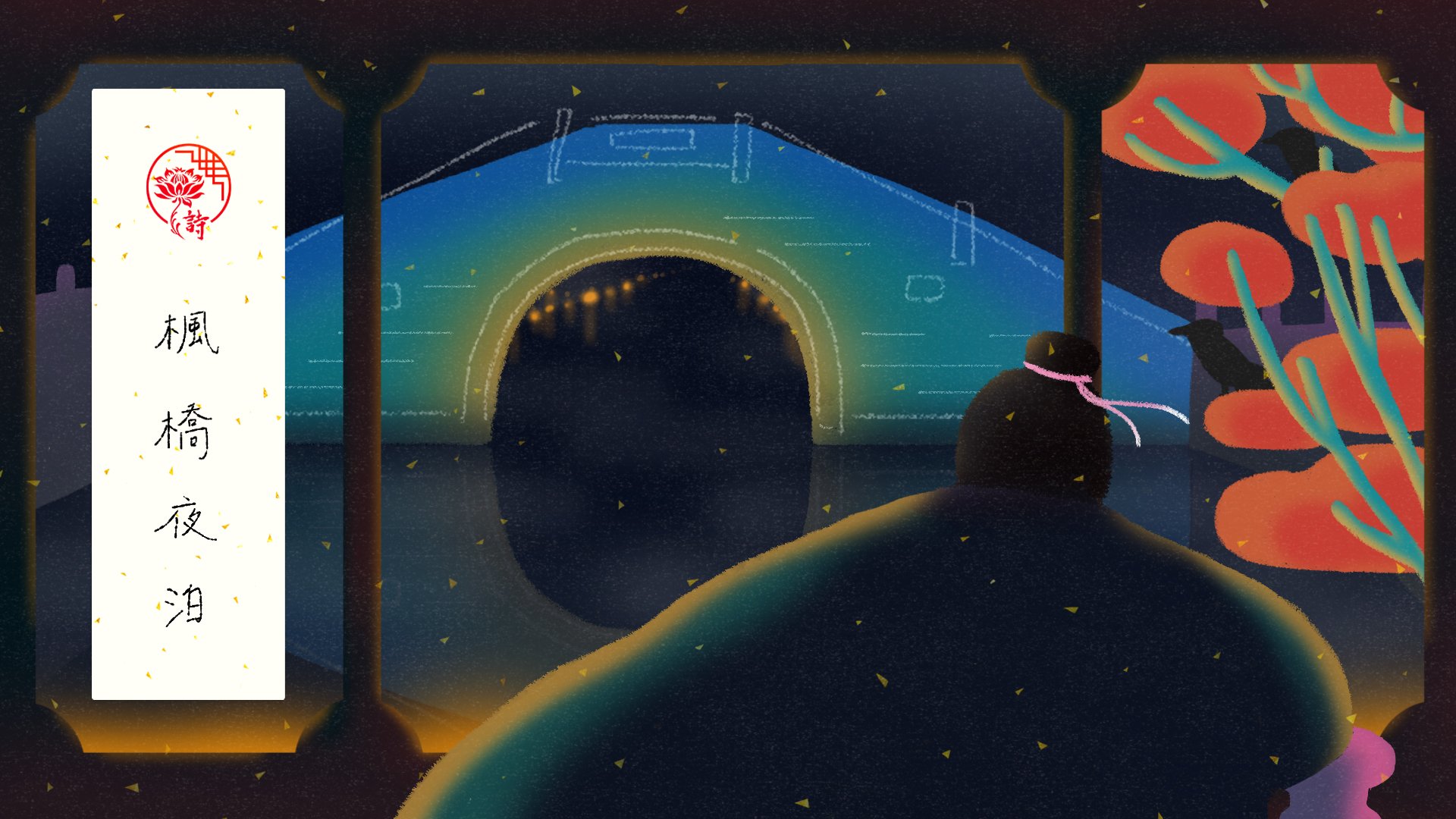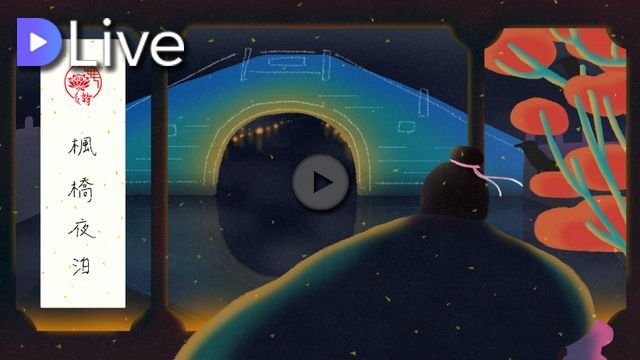Hi everyone! We’re back again! If you’re a nomad writing on Steemit, do you think about home and past memories often? When you’re alone in front of your laptop, beer in hand, does the loneliness sometimes make you sad? Memories, alcohol and sadness often go hand in hand, at least it did in the old days and in the last two posts, we introduced poems about wine and sad memories. When the night comes, it seems to intensify our sadness, unlocking emotions that we’ve hidden away somewhere, that’s why today we want to present to you a Tang poem about night time - “A Night Mooring by the Maple Bridge” by Zhang Ji.
大家好,再次來到《樂筆詩塾》,讓我們再度回到Steemit的詩鄉,卻不知此時此際,旅居的遊子們,思鄉嗎?寫著這篇文章時,筆者獨自一人坐在電腦前,舉頭獨酌,正正是為了排解思愁,但看來,愁,更愁。
思、酒、愁,三者往往密不可分,思帶酒、酒帶愁,在人生的道路,有情的人總有那樣買醉思愁的時候。在上兩回的樂筆思塾,我們介紹了有關酒和思念的唐詩,兩首詩都帶著淡淡的愁,漆黑月夜,萬籟寂時,景生情下,思愁不禁浮現。夜,彷彿就是情感的催化劑,引思、換愁,對!今天我們要介紹的唐詩,正是一首與夜有關的唐詩 ,它是張繼所寫的《楓橋夜泊》。
The Background創作背景

Amongst the Tang poets, Zhang Ji isn’t as well known as his contemporaries such as Li Bai, Du Fu and Li Shangyin, all whom we’ve introduced in the previous posts. However, his most famous poem, “A Night Mooring by the Maple Bridge” is considered a classic and is studied by many today.
On an autumn evening, the poet moored his boat by the Maple Bridge in Suzhou and he was fascinated by the serenity of the evening and the tranquility around him.
The poem mentions “gū sū”, this is modern day Suzhou. In the south west of Suzhou, there is Hanshan Temple, and by the temple are two bridges, Jiancun Bridge and Maple Bridge. This poem is based on the latter.
Maple Bridge is so called as there are many maple trees by this stretch of river, but sometimes it is also known as Seal Bridge (ie sealing or closing off something), as the two words sound the same in Chinese. According to historical records, the second name came about because in those days there was quite a lot of pirates and robbery around the river side, so the bridge was closed off overnight. None of the vessels could pass through at night time, so Zhang had to stay on board overnight, making him feel a bit lonely and stranded.
在唐代的詩人中,雖然《楓橋夜泊》的作者張繼在名聲上不如李白、杜甫、李商隱等風流人物,但他依然寫出這首意境深遠的名篇,流傳千古。張繼活躍於唐朝天寶年間,這時期正是強大的唐朝由盛轉衰的轉捩點,皆因一次地方將領叛變,史稱「安史之亂」。
在一個秋天的夜晚,詩人泊船蘇州城外的楓橋。江南水鄉秋夜幽美的景色,吸引着這位懷着旅愁的遊子。
詩文裡面提及的「姑蘇」,即今日的「蘇州」。西面有一座「寒山寺」,旁邊有兩座橋,名為「江村橋」和「楓橋」,其中一座橋正是詩題的「楓橋」。
《大清一統志》記載,「楓橋」又叫「封橋」,除了江邊種滿一片楓樹之外,亦與「封鎖」有關。「封橋」原是水路交通要道,是往來船隻停泊的碼頭。唐代經常有水匪倭寇出沒,趁機在江邊上岸掠劫。為了安全考量,夜晚都要將橋封鎖起來,因而起名叫「封橋」。由於封鎖政策,夜間的「楓橋」不像今日早晚貨如輪轉的碼頭,所以詩人只能滯留於江邊的客船上度宿,更感到一番飄泊、寂靜、冷清的氣氛。

A Night Mooring by the Maple Bridge by Zhang Ji 張繼《楓橋夜泊》

月落烏啼霜滿天,江楓漁火對愁眠。
yuè luò wū tí shuāng mǎn tiān , jiāng fēng yú huǒ duì chóu mián 。
姑蘇城外寒山寺,夜半鐘聲到客船。
gū sū chéng wài hán shān sì , yè bàn zhōng shēng dào kè chuán 。
The Composition 詩句大意
There are four lines in A Night Mooring by the Maple Bridge, and is best explained in three parts.
《楓橋夜泊》共四句,按詩的結構劃分,可分為三個層次。
Part 1 : The night view on a quiet evening 層次一:靜夜的天空景觀
「月落烏啼霜滿天」
yuè luò wū tí shuāng mǎn tiān
The moon has gone down, the raven is calling, and the sky is covered in white frost
解釋:月亮已落下,烏鴉在啼叫,白霜彌漫整個天空。
Part 2 : The river view on a quiet evening 層次二:靜夜的江邊景觀
「江楓漁火對愁眠」
jiāng fēng yú huǒ duì chóu mián
The maples by the river and the lights from the boats, makes me sad and keeps me awake at night
解釋:我對著江邊的楓樹與船上的漁火,滿懷愁緒 ,難以入眠。
Part 3 : Breaking the silence at night 層次三:打破靜夜的聲音
「姑蘇城外寒山寺,夜半鐘聲到客船。」
gū sū chéng wài hán shān sì , yè bàn zhōng shēng dào kè chuán 。
The Hanshan Temple outside of Gu Su are ringing their bells, and the midnight chimes travel all the way to my boat
解釋:姑蘇城外的寒山古寺,在半夜敲響一陣鐘聲,傳到我乘坐的客船裏。

The Poetic Structure 格律特點
Sentence 句式
There are four lines in this poem making it a quatrain (a poem that consist of four lines) , and each line has seven words, so this is classified as a 7 word quatrain.
全詩共四句,符合絕詩四句的句式特點。而全詩每句均是工整的七個字,可先將此詩納為「七言絕詩」。
Rhythm 押韻
The final in the last word in the second line is mián and in the fourth line is chuán. Both end with the same final “n” thus follows the rhyming characteristic required for a 7 word quatrain
先選取雙句句末的字作韻母分析,即「眠」、「船」。「眠」的粵音韻母是「in」,普通話韻母是「ian」;「船」的粵音韻母是「yun」,普通話韻母是「uan」。
以「n」韻尾構成的韻母叫「前鼻韻母」,因此《楓橋夜泊》以「n」一韻到底,符合「絕詩」的押韻特點,可以判斷此詩屬於「七言絕詩」。

The Music and Sketch 《楓橋夜泊》的歌與畫
This week we are honoured to have @susanlo sing the Mandarin version for us. The Cantonese version is performed by @tine. The music that we have composed for A Night Mooring by the Maple Bridge takes on a slight sombre tone to reflect the poet’s mood at night time. The multi talented @susanlo also performs the guzheng for us here, and the live performance elevates the mood of the song to another level. We hope you will enjoy it.
這一次我們很高興邀請了@susanlo為我們演唱國語部份!她更為我們獨奏了一段古箏演出!而粵語版則是由@tine演唱。《楓橋夜泊》的曲風走的是悲愁的風格,一如詩中所表達的情感,配上一段古箏幽怨細膩的獨奏,讓整首歌曲更添愁情,請大家細心欣賞。

With this poem being a quatrain with just four lines, it was amazing how Zhang Ji was able to describe his mood through so many scenes such as the moon, the craven, the frost, maple, boat, river and temple. To translate this into a single sketch was quite a challenge for us, and after many reiterations, we finally came up with the following which we think encompasses the tone of the poem.
這次的作畫過程是我們的一次大挑戰,張繼在短短四句詩中,竟能表達出那麼多的東西,單是物件,就有月亮、烏鴉、白霜、楓樹、船、江河、古寺,要在豐富的環境下表達詩人那種落寞與孤寂,並不容易。最後經過多次的刪減,我們終於得到了這一幅完成作!

Highlight from the poem 精選句子

「夜半鐘聲到客船」
yè bàn zhōng shēng dào kè chuán
“The midnight chimes travel all the way to my boat”
In Hong Kong, when we admire the night scenery we normally go up to the famous Peak and look back down to the beautiful view. We rarely have the opportunity to sit by the peaceful river side and listen to bells chiming like Zhang Ji did.
In the poem, we can visualise the moon from far above, the ravens calling in the sky, the frosty night, maples by the river and lights from the boats. Then we have the sleepless traveller on the boat, stranded overnight not going anywhere. Suddenly, the silence is broken by the bells chimes from far away. Although physically awake, the chimes awakes Zhang Ji from his deep thoughts. Sitting in his boat which rocks gently in the river, all this makes him even more sadder.
在香港,偶爾有閒情逸致欣賞夜景,也不過是在山頂俯瞰維港風景。甚少有機會像詩人張繼一樣,可以在江邊的船上體驗夜半的寂靜。
環視江邊四周,由遠至近:「月落」、「烏啼」、「霜滿天」、「江楓」、「漁火」,然後目光漸漸移向泊船上的一夜未眠的客人,充滿豐富的即視感。然後半夜間,一道鐘聲由姑蘇城外寒山寺傳到船上,以鐘聲打破維持了徹夜的寧靜,視覺融入聽覺,是立體的感官體驗。「夜半鐘聲到客船」,如同一聲明悟,點破詩人的愁意,襯托夜的深沉。詩人在飄泊不定的船上臥聽鐘聲,更是萬般愁意點滴在心頭。

The Maple River which inspired Zhang Ji to write this poem is located by Hanshan Temple in modern day Suzhou. Today Suzhou is one of China’s most beautiful city and is famous for its network of rivers and canals. Rivers are an important feature of China’s landscape, and often they have become the catalyst for economic, art and cultural development. Out of all the rivers, the most famous one is Qinhuai River, a tributary of the Yangtze River. Next week, we will present a poem related to the Qinhuai River.
詩人張繼坐在夜半的楓橋,眼看橋封的江邊,感概萬千。楓橋位於今天蘇州寒山寺下,已成蘇州一大名勝,是中國江南水鄉的重要體現。江南水鄉是中國南方一大特色,江南縱橫,造就絕美景色,同時帶動古中國的經濟、藝術及文化發展。萬千河陌中,最著名的自然是秦淮河了,在下一篇的文章中,我們將會介紹一首與秦淮河有關的文章,大家要留意啊!
Production Team 製作團隊
Literature Guide 導讀: @perlia
Literature Translation 詩歌解析: @perlia
Music 音樂: @kona
Art 插圖: @nanosesame
Video 視頻: @aaronli
English Editor 英語編輯: @livinguktaiwan
Chinese Editor 中文編輯: @aaronli

My video is at DLive

